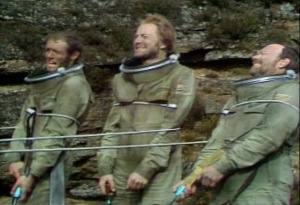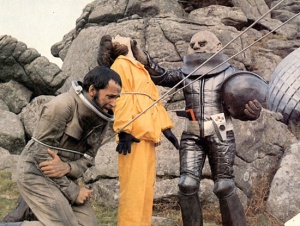This season of Doctor Who has been presented as one continuous journey, as the Doctor, Sarah and Harry travel by Tardis, transmat beam and time ring from one adventure to the next. Not letting the expensive Ark in Space sets go to waste, our heroes return to Nerva space station thousands of years earlier, when it was simply a beacon for travelling ships, only to find that it has had the worst luck in space history, having been the target for a Cybermen attack!
Seeing the Cybermen in colour for the first time should be exciting but, being silver, they don’t actually look any different. Their voices in this story are terrible, almost devoid of electronic sounds, and far too emotional, too human. Their plan is to blow up a rogue planetoid (Voga) that contains a vast supply of gold, because apparently gold is deadly to the Cybermen. Once this is done, they will be free to invade Earth or something. They enlist the help of one of the Nerva station staff, who appears to be a traitor but is actually working for the Vogans to destroy the Cybermen on the station with a rocket from the planet and the- oh no I’ve gone cross-eyed.
Even Harry has trouble keeping up as he struggles at one point to fill the Doctor in on what’s happening. I’m starting to like Harry, with his chipper attitude and stiff-upper-lipped-ness, although for a trained medical professional, he does often play the fool.
I don’t know how they managed to make a Cybermen story both convoluted and boring, but somehow they did. The Vogan power struggle is boring, much of the dialogue is too dry, the Cybermen are unthreatening and if it wasn’t for Tom Baker being occasionally entertaining, the whole thing would have been bust. I lost the plot around part 3 but I suppose the conclusion was exciting, and at least it was only four parts long. It’s a shame it wasn’t better because the rest of this season has been of unusually consistent quality and now it’s ended on a bit of a duff note.
With the Tardis returned, the Doctor, Sarah and Harry return to Earth. Apparently the Brigadier is having a spot of bother…




















